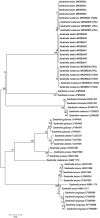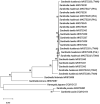DNA barcoding cannot discriminate between Sardinella tawilis and S. hualiensis (Clupeiformes: Clupeidae)
- PMID: 33365600
- PMCID: PMC7687547
- DOI: 10.1080/23802359.2019.1638839
DNA barcoding cannot discriminate between Sardinella tawilis and S. hualiensis (Clupeiformes: Clupeidae)
Abstract
Sardinella tawilis, the only known freshwater sardinella in the world, is endemic to Taal Lake, Philippines. Previous studies found the Taiwan sardinella, S. hualiensis, to be morphologically very similar to S. tawilis and identified it as the marine sister species of S. tawilis. In this study, DNA barcoding using the mitochondrial cytochrome c oxidase I (COI) gene was carried out to analyze species demarcation in the Sardinella genus, focusing primarily on the relationship between S. tawilis and S. hualiensis. The neighbour-joining (NJ) tree that was constructed using Kimura 2-parameter (K2P) model showed a single clade for the two species with 100% bootstrap support. K2P interspecific genetic divergence ranged from 0% to 0.522%, which is clearly below the suggested 3-3.5% cutoff for species discrimination. Recombination activating gene 1 (RAG1), mitochondrial control region (CR), cytochrome b, 16S rRNA, and S7 markers were used to further validate the results. Sardinella tawilis and S. hualiensis clustered together with a bootstrap support of 99-100% in each of the NJ trees. Low interspecific genetic distances between S. tawilis and S. hualiensis for all the markers except CR could be attributed to incipient allopatric speciation.
Keywords: COI; DNA barcoding; RAG1; Sardinella hualiensis; Sardinella tawilis.
© 2019 The Author(s). Published by Informa UK Limited, trading as Taylor & Francis Group.
Conflict of interest statement
No potential conflict of interest was reported by the authors.
Figures


References
-
- Chow S, Hazama K. 1998. Universal PCR primers for s7 ribosomal protein gene introns in fish. Mol Ecol. 7:1247–1263. - PubMed
-
- Chu K, Tsai C. 1958. A review of the clupeid fishes of Taiwan with description of a new species. Q J Taiwan Mus. 11:103–128.
-
- Dasmahapatra KK, Mallet J. 2006. Taxonomy: DNA barcodes: recent successes and future prospects. Heredity. 97:254–255. - PubMed
-
- Hall T. 1999. Bioedit: a user-friendly biological sequence alignment editor and analysis program for Windows 95/98/NT. Nucleic Acids Sympo Ser. 41:95–98.
-
- Hargrove TR. 1991. The mysteries of Taal: a Philippine volcano and lake, her sea life and lost towns. Manila (Philippines): Bookmark Publishing.
LinkOut - more resources
Full Text Sources
